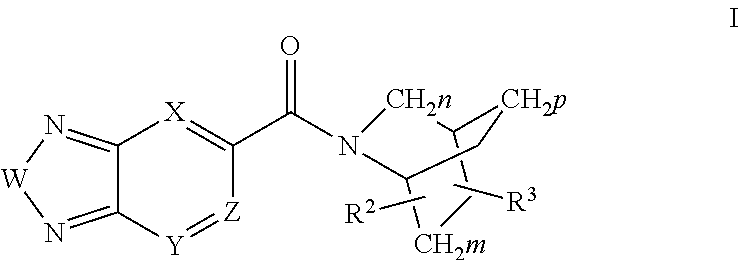Methods for the treatment of respiratory depression
a technology for respiratory depression and treatment, applied in the field of respiratory depression, can solve problems such as schizophrenia or schizophreniform behavior, and achieve the effects of stabilizing the baseline of evoked to responses, and increasing the field amplitud
- Summary
- Abstract
- Description
- Claims
- Application Information
AI Technical Summary
Benefits of technology
Problems solved by technology
Method used
Image
Examples
example 1
8-Azabicyclo[3.2.1]oct-8-yl([2,1,3]-benzoxadiazol-5-yl)methanone
[0111]
[0112]To a solution of tropane (2.5 g, 20 mmol) in toluene (80 ml) was slowly added [2,2,2]-trichloroethyl chloroformate (20 ml, 94.4 mmol) and Na2CO3 (1.5 g, 14 mmol). The mixture was heated to 110° C. overnight. The solution was cooled to room temperature, ethyl acetate (150 ml), water (100 ml) and H2SO4 (→pH 2) were added. The organic phase was dried over sodium sulfate, and concentrated under vacuum to yield 9.3 g colorless oil.
[0113]The preceding product (3.3 g) was dissolved in THF (50 ml) and methanol (50 ml), and freshly prepared Zn / Cu (15 g) was added followed by formic acid (5 ml). The mixture was stirred at room temperature for 20 minutes before filtering the solids and evaporating the solvent until ˜10 ml remained. Concentrated sodium hydroxide solution was added until pH 10 was reached and the mixture extracted with chloroform (100 ml) and the organic phase dried over sodium sulfate. Triethylamine (2 ...
example 3 and example 4
[2,1,3]-Benzoxadiazol-5-yl(3,3-difluoro-8-azabicyclo[3.2.1]oct-8-yl)methanone and [2,1,3]-benzoxadiazol-5-yl(3-fluoro-8-azabicyclo[3.2.1]oct-2-en-8-yl)methanone
[0116]
[0117]To a solution of 8-([2,1,3]-benzoxadiazol-5-ylcarbonyl)-8-azabicyclo[3.2.1]octan-3-one (0.67 g, 2.45 mmol) in dichloromethane (25 ml) was slowly added diethylaminosulfur trifluoride, “DAST” (5 g). The mixture was stirred at room temperature for 3 days and then slowly poured into a mixture of NaHCO3 solution (100 ml) and chloroform (100 ml). The aqueous phase was extracted with chloroform (100 ml) and the combined organics were dried over sodium sulfate, concentrated under vacuum and the residue purified by silica gel chromatography eluting with hexane / ethyl acetate (65:35), to give [2,1,3]-benzoxadiazol-5-yl(3,3-difluoro-8-azabicyclo[3.2.1]oct-8-yl)methanone (0.37 g) after crystallization from dichloromethane / MTBE and as the less polar of 2 products: mp=165-166° C., LC-MS, MH+=294; 1H NMR (300 MHz, CDCl3) δ 7.96-7...
example 5
endo-[2,1,3]-Benzoxadiazol-5-yl(3-hydroxy-8-azabicyclo[3.2.1]oct-8-yl)methanone
[0119]
[0120]To a solution of tropine (4.0 g, 28.3 mmol) in toluene (50 ml) was slowly added [2,2,2]-trichloroethyl chloroformate (16 ml, 75.5 mmol) and Na2CO3 (4.0 g, 37.7 mmol). The mixture was heated to 110° C. for 42 hours, the toluene removed under vacuum, water (150 ml) and H2SO4 (→pH 2) were added, and the mixture extracted with ethyl acetate (2×100 ml). The combined organics were dried over sodium sulfate, concentrated under vacuum and the residue chromatographed on silica gel using hexane / ethyl acetate (70:30)→(40:60) to give a white solid (6.0 g). To a solution of the preceding product (2.5 g, 8.26 mmol) in THF (50 ml) and methanol (50 ml), was added freshly prepared Zn / Cu (15 g) and the mixture stirred at room temperature for 18 h. The solids were filtered off, the solvent evaporated and to the residue, dissolved in DMF (60 ml), were added DMAP (0.98 g, 8 mmol), HOBT (0.54 g, 4 mmol), triethylam...
PUM
| Property | Measurement | Unit |
|---|---|---|
| temperature | aaaaa | aaaaa |
| temperature | aaaaa | aaaaa |
| pH | aaaaa | aaaaa |
Abstract
Description
Claims
Application Information
 Login to View More
Login to View More - R&D
- Intellectual Property
- Life Sciences
- Materials
- Tech Scout
- Unparalleled Data Quality
- Higher Quality Content
- 60% Fewer Hallucinations
Browse by: Latest US Patents, China's latest patents, Technical Efficacy Thesaurus, Application Domain, Technology Topic, Popular Technical Reports.
© 2025 PatSnap. All rights reserved.Legal|Privacy policy|Modern Slavery Act Transparency Statement|Sitemap|About US| Contact US: help@patsnap.com



